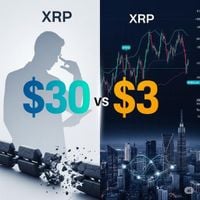Ripple's XRP token has been making waves in the cryptocurrency market throughout July 2025, capturing the attention of traders, analysts, and investors alike. On July 26, XRP was trading at around $3.18, marking a 4.01% increase that outpaced the broader digital asset market. This surge followed Ripple's strategic move to apply for new payment licenses in major Asian markets, a development that sparked optimism about the token's potential for expanded cross-border remittance utility and regulatory clarity.
Ripple's licensing efforts in Asia are part of a broader strategy to cement its position in the rapidly evolving digital payments and blockchain infrastructure landscape. Investors view these moves as opening new pathways for XRP-based transactions, potentially enhancing the token's real-world use in international payments. Technically, XRP has been approaching a resistance level that has held firm for several months. Despite increased volatility as prices pushed beyond recent trading ranges, a clear breakout has yet to materialize, leaving traders cautiously optimistic.
The market sentiment around XRP has been mixed but leaning towards positivity. Following the licensing news, trading volumes surged, and social media buzz among crypto enthusiasts grew. However, lingering legal and regulatory uncertainties, especially related to ongoing litigation with the U.S. Securities and Exchange Commission (SEC), have kept some investors wary. For instance, after a U.S. district court rejected Ripple Labs' motion to dismiss the SEC lawsuit, XRP's price slipped to around $3.03, testing key support levels.
Meanwhile, cryptocurrency analyst Amonyx reignited debate over XRP's valuation by asserting that, based on its 2018 ratio to Bitcoin, XRP's price should exceed $30 today. This claim stems from XRP's 2018 Bitcoin-denominated price of approximately 0.0002247 BTC, which, when applied to Bitcoin's current value near $117,300, mathematically suggests an XRP price north of $30. However, many analysts caution that the 2018 ratio was driven more by speculative hype than sustainable utility. Back then, XRP enjoyed high expectations due to Ripple's payment technology and global adoption prospects, reaching third place in market capitalization. Today's market is markedly different: Bitcoin has solidified itself as a store of value and institutional asset, while XRP remains a payment-focused token grappling with regulatory challenges.
In 2025, XRP has shown mixed performance. It surpassed its 2018 high of $3.40, even reaching $3.66 mid-month, but failed to keep pace with Bitcoin's rapid ascent. Regulatory clarity and corporate partnerships, like Ripple's RLUSD stablecoin initiative, have bolstered the ecosystem, yet institutional adoption lags behind Bitcoin. Price volatility remains a concern, with XRP experiencing a 10% drop in mid-July. Price forecasts vary widely: some major institutions predict XRP could rise to between $7 and $15 within 12 to 18 months, while the $30 target is seen as achievable only if significant new catalysts emerge. Optimistic models, including AI-driven ones like DeepSeek, even project a $30 price by 2026, contingent on broader financial institution adoption of liquidity solutions. Conversely, more conservative predictions, such as those from CoinCodex, anticipate a narrower range of $3.00 to $3.62 for 2025.
Adding to XRP's intrigue, technical analysts have identified a rare and potentially bullish pattern on its long-term charts. Crypto analyst JD highlighted a symmetrical triangle pattern and a breakout accompanied by strong Relative Strength Index (RSI) and Moving Average Convergence Divergence (MACD) signals—echoing the setup that preceded XRP's explosive 2017 bull run. Currently, XRP's RSI stands at 71.93, having broken above a major resistance, while MACD shows a bullish crossover. JD interprets recent short-term price dips as mere "emotional traps," suggesting these are buying opportunities that do not undermine the overall bullish trend. However, he cautions that after such surges, corrections are possible; during the last bull market, XRP fell 70% at one point. Virtual asset expert Shawn Marks supports the bullish outlook, noting XRP's 92% rally over the past month—from $1.95 to $3.60—and foresees potential rallies to $10 to $15. Marks describes recent corrections as healthy and not indicative of trend reversals, reinforcing the narrative of sustained upward momentum.
Despite these promising technical signals, XRP's price has been volatile. After peaking at $3.66 mid-July, the token sharply declined over 14% following a transfer of approximately 50 million XRP from a Ripple co-founder’s wallet to exchanges—a move interpreted as profit-taking that rattled investor sentiment. Nonetheless, buying interest returned near the psychological $3.00 support, prompting a rebound to about $3.15 by July 26. XRP maintains a significant market presence, with a market capitalization near $18.6 billion and a 24-hour trading volume of $70 million. Its circulating supply is roughly 59.2 billion tokens, out of a total capped supply of 100 billion. XRP operates on the permissionless XRP Ledger (XRPL), known for high-speed transactions. Recent technological upgrades, such as the introduction of an Ethereum Virtual Machine (EVM)-compatible sidechain, have expanded its developer ecosystem, enabling greater deployment of smart contracts and decentralized applications (dApps).
Looking ahead, experts agree that XRP’s trajectory will hinge on several key factors: further regulatory developments, especially the outcome of its legal battles with the SEC; movements from major Ripple-related wallets; and the expansion of practical use cases leveraging XRPL-based services. Ripple’s ongoing efforts to deepen partnerships with institutional financial entities, including its application for a banking license to support its RLUSD stablecoin, signal a commitment to broadening XRP’s utility in global remittances and payments.
Meanwhile, Ethereum and Ripple have been outpacing Bitcoin in recent months, fueling expectations of an "altcoin season." Over the past month, Ethereum and Ripple have surged roughly five times more than Bitcoin, with monthly gains of 49.7% and 43.1% respectively, compared to Bitcoin’s 8.74%. This momentum has led to a decline in Bitcoin’s market dominance—from around 66% at June’s end to 61% recently—as investors diversify into altcoins. Spot trading volumes have also shifted, with Ethereum’s recent volume surpassing Bitcoin’s for the first time in over a year. Institutional flows mirror this trend: Ethereum spot ETFs have seen 15 consecutive days of net inflows, while Bitcoin ETFs experienced net outflows over three days.
These shifts are partly attributed to favorable U.S. regulatory developments. On July 19, 2025, President Donald Trump signed the GENIUS stablecoin regulation bill, formalizing the stablecoin era and expected to benefit Ethereum and Ripple directly. Most stablecoins are Ethereum-based, boosting demand for Ethereum’s transaction fee token, while Ripple’s RLUSD stablecoin expansion plans include applying for a U.S. banking license. Analysts from Swissblock note that 75% of altcoins have reached technical resistance levels, signaling a pivotal moment that could usher in a strong altcoin season, characterized by falling Bitcoin dominance and broad capital rotation into altcoins. Should this scenario unfold fully, the total altcoin market capitalization could soar to $5 trillion, a 400% increase from current levels.
However, the altcoin rally comes with warnings about volatility. Ripple itself experienced a rapid price swing—from 4935 KRW (about $3.65) on July 21 to 4019 KRW (about $3.00) just three days later. Ethereum saw a similar pattern, dropping from over 5.2 million KRW to 4.75 million KRW. Experts attribute these sharp moves to profit-taking and caution investors to be mindful of the high volatility inherent in altcoin markets.
In sum, XRP’s journey through July 2025 illustrates the complex interplay of regulatory, technical, and market forces shaping its path. From licensing ambitions in Asia and renewed technical patterns reminiscent of past bull runs, to valuation debates and broader altcoin dynamics, XRP remains a focal point in the evolving cryptocurrency landscape. Investors and observers will be watching closely as Ripple navigates its legal challenges, regulatory approvals, and ecosystem expansions, all of which will be critical in defining XRP’s next chapter.





